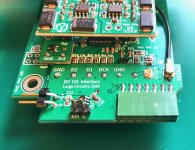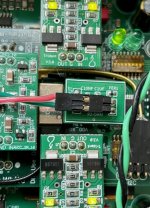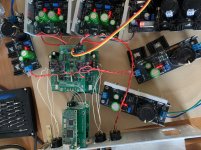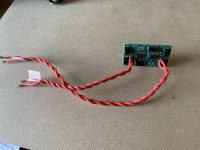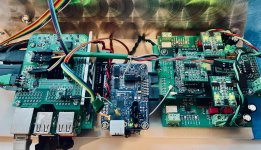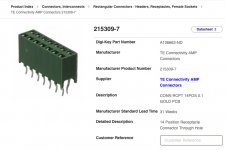I re-flashed the Amanero with current firmware and have gotten it working, but am getting the roaming intermittent static some have reported playing DSD 64. I can't get anything higher to play without losing lock.
Separately, I have been comparing the 9038/mercury to a 9028/mercury or legato. The 9028, even with the same mercury output stage, has better bass while the 9038 sounds thin. I'm not sure what's going on but have been trying to get the 9038 to sound "right" for a while now. DSD playback does sound better, but that's not an option for a lot of streaming and I wonder if there's some playback issue I need to address with the 9038.
Separately, I have been comparing the 9038/mercury to a 9028/mercury or legato. The 9028, even with the same mercury output stage, has better bass while the 9038 sounds thin. I'm not sure what's going on but have been trying to get the 9038 to sound "right" for a while now. DSD playback does sound better, but that's not an option for a lot of streaming and I wonder if there's some playback issue I need to address with the 9038.
Same resistors in Mercury for both 9028 and 38? If so, it could be an effect of whatever control you use to equalize the volumes - the 38 being presumably 4X more attenuated.The 9028, even with the same mercury output stage, has better bass while the 9038 sounds thin.
I've found that some uFl cables are not good after too many installations/removals. Pure speculation: perhaps switch to new ones and as short as possible. Or as a test direct solder very short wires into the B3... I've started using a little edge modification to the B3s that employs gold pins. Although they are soldered onto the B3, they can be disassembled and re-assembled to the I2S/DSD source more often than uFl wires with little ill effect.I'm not sure what's going on but have been trying to get the 9038 to sound "right" for a while now
Good luck!
Attachments
Last edited:
Did you change the resistors when switching to the SE9038?
They should be, the 38 puts out 4 times as much current as the 28!
They should be, the 38 puts out 4 times as much current as the 28!
I re-flashed the Amanero with current firmware and have gotten it working, but am getting the roaming intermittent static some have reported playing DSD 64. I can't get anything higher to play without losing lock.
Separately, I have been comparing the 9038/mercury to a 9028/mercury or legato. The 9028, even with the same mercury output stage, has better bass while the 9038 sounds thin. I'm not sure what's going on but have been trying to get the 9038 to sound "right" for a while now. DSD playback does sound better, but that's not an option for a lot of streaming and I wonder if there's some playback issue I need to address with the 9038.
I initially set the mercury up for use with the 9038, so when switching to the 9028 I left the resistor and the output level was lower but still plenty of volume with my amp/speakers.
I have had issues with UFl cables before and am planning to try direct soldered silver but that still wouldn't explain the improvement in sound when going from the 9038 to 9028.
I am using a shunt power supply on the DAC and thought it may have been limiting current, but I get the same issue when using a linear supply. I have a vague sense that something may not be being powered fully/properly with the 9038 but given that any issues go away with the exact same set-up and swapping in the 9028 I'm at a bit of a loss.
I have had issues with UFl cables before and am planning to try direct soldered silver but that still wouldn't explain the improvement in sound when going from the 9038 to 9028.
I am using a shunt power supply on the DAC and thought it may have been limiting current, but I get the same issue when using a linear supply. I have a vague sense that something may not be being powered fully/properly with the 9038 but given that any issues go away with the exact same set-up and swapping in the 9028 I'm at a bit of a loss.
Agreed, the chips should not sound very different. Even the es9018 does not sound very different from the 38 imo. So power issues may indeed be the issue, the 3,3V analog can draw lots of current. Are you using the latest trident moidules?
I initially set the mercury up for use with the 9038, so when switching to the 9028 I left the resistor and the output level was lower but still plenty of volume with my amp/speakers.
I have had issues with UFl cables before and am planning to try direct soldered silver but that still wouldn't explain the improvement in sound when going from the 9038 to 9028.
I am using a shunt power supply on the DAC and thought it may have been limiting current, but I get the same issue when using a linear supply. I have a vague sense that something may not be being powered fully/properly with the 9038 but given that any issues go away with the exact same set-up and swapping in the 9028 I'm at a bit of a loss.
What points would I measure to test peak to peak voltage? + and gnd on se or balanced out?
I was using them, but have been using Sparkos regulators providing 3.6v. They have plenty of current and are fed by shunts set at about 300ma.
Earlier this year the DAC was working great until I accidentally swapped the VDD trident and XO trident trying to get sync mode to work. After I realized I mixed them up, I swapped them again but wasn't getting lock. I measured 345mv between gnd and out of the VDD regulator insetad of 1.3v. I ordered a new 1.3v trident and got sound again.
I don't think this could have done anything if I am still getting sound, but that's the only obvious issue I can think of.
When I was swapping in new power supplies I was getting good bass, but somewhere along the way it started sounding thin. I thought that was just the sound, until I had the 9028 to compare it to again.
I was using them, but have been using Sparkos regulators providing 3.6v. They have plenty of current and are fed by shunts set at about 300ma.
Earlier this year the DAC was working great until I accidentally swapped the VDD trident and XO trident trying to get sync mode to work. After I realized I mixed them up, I swapped them again but wasn't getting lock. I measured 345mv between gnd and out of the VDD regulator insetad of 1.3v. I ordered a new 1.3v trident and got sound again.
I don't think this could have done anything if I am still getting sound, but that's the only obvious issue I can think of.
When I was swapping in new power supplies I was getting good bass, but somewhere along the way it started sounding thin. I thought that was just the sound, until I had the 9028 to compare it to again.
OK...
My build works perfectly with DSD 256 via Amanero/Cronus-
Buffalo 9038 PRO-Mercury
Amanero/Cronus with 2006be 11 firmware, with Native DSD 256 served up from a Sonore Renderer running its proprietary, linux based OS, Cronus with a 45.1584, NDK SDA aeries XO, with .01µF bypass cap (C0G) on the Rhea board
I sync clock the 9038 (master clock from the Cronus, with clock regulator removed on the Buffalos' DAC board to de-power the onboard oscillator).
The 9038 DAC requires more current than 9028/9018, so make sure the power supplies are stout. Also make sure you are using the newer Trident versions, especially the 1.3 volt version (not the older 1.2 V model).
I have no problems using u.fl, just keep them to 10 cm or less, and do not reuse many times.
This set up sounds fantastic for me, pretty much as good as one can get with any ESS based DAC. I do have a few parts mods on the Mercury, but doubt that those make any huge differences in sound quality. (Z-foils in the feedback resistors, Amtrans film/foils for the filter caps).
I only send DSD 256 to the DAC, via oversampling either with Roon or HQPlayer, and much prefer this to any PCM rate.
I re-flashed the Amanero with current firmware and have gotten it working, but am getting the roaming intermittent static some have reported playing DSD 64. I can't get anything higher to play without losing lock.
Separately, I have been comparing the 9038/mercury to a 9028/mercury or legato. The 9028, even with the same mercury output stage, has better bass while the 9038 sounds thin. I'm not sure what's going on but have been trying to get the 9038 to sound "right" for a while now. DSD playback does sound better, but that's not an option for a lot of streaming and I wonder if there's some playback issue I need to address with the 9038.
My build works perfectly with DSD 256 via Amanero/Cronus-
Buffalo 9038 PRO-Mercury
Amanero/Cronus with 2006be 11 firmware, with Native DSD 256 served up from a Sonore Renderer running its proprietary, linux based OS, Cronus with a 45.1584, NDK SDA aeries XO, with .01µF bypass cap (C0G) on the Rhea board
I sync clock the 9038 (master clock from the Cronus, with clock regulator removed on the Buffalos' DAC board to de-power the onboard oscillator).
The 9038 DAC requires more current than 9028/9018, so make sure the power supplies are stout. Also make sure you are using the newer Trident versions, especially the 1.3 volt version (not the older 1.2 V model).
I have no problems using u.fl, just keep them to 10 cm or less, and do not reuse many times.
This set up sounds fantastic for me, pretty much as good as one can get with any ESS based DAC. I do have a few parts mods on the Mercury, but doubt that those make any huge differences in sound quality. (Z-foils in the feedback resistors, Amtrans film/foils for the filter caps).
I only send DSD 256 to the DAC, via oversampling either with Roon or HQPlayer, and much prefer this to any PCM rate.
Reviving a dormant thread:
I'm wondering if it would be possible to supply both AVCC on the 9028 with a completely separate supply. I'm thinking either a 3.3V LiFePO4 cell for both, or 1 cell for each AVCC L and R.
Has anyone tried this? Or tried powering the AVCC pins of the 9028/9038 independently from the rest of the BIII board?
Looking through old posts here, yes I have been doing this. Possum has posted a few times on the TPA website about doing this also. I've tried feeding them 3.3v directly and also feeding the tridents with their own external power. Feeding the AVCC tridents with external power was a big improvement. I'm currently feeding two Sparkos regulators that output 3.6v with two separate ultrabibs.
I plan to ultimately have one toroid power the left side of the i/v stage and AVCC L and another to power the right side.
I'm currently feeding two Sparkos regulators that output 3.6v with two separate ultrabibs.
I plan to ultimately have one toroid power the left side of the i/v stage and AVCC L and another to power the right side.
I'm curious about how the level of AVCC supply 'separation' affects the sonic benefit. IIRC @Barrows added a dedicated regulator (or two?) on a shared transformer, which is obviously easier than adding another AC source. How does that measure?
In the rigs I'm tweaking now, the 'clean' linear supply at the Buff3 terminals (from a TPA Centaur) is pretty quiet except for about +/- 10 millivolts at 100 megahertz. ...and that's with the Buff3 clock un-powered. If I take that 5v and power an LT3045 set up for 3.3v, run it through a twisted pair over to the B3 clock trident socket, then finally run it through a mini passive filter with ferrite (pictured), *that power source* is quieter than what otherwise comes from the 3.3v trident output. (My old scope isn't good enough to say exactly how much quieter.). What I would love is to accomplish some of any benefit of a fully separate power circuit to the AVCC only with whatever might fit on a small active 'pre-filter'. If the Sparkos discrete regulator isn't really optimal, then the idea may not be worth pursuing. I think I read somewhere that general current and impedance considerations for amp supplies (in addition to noise) also apply to the AVCC supply. For me, adding a separate transformer is probably never gonna happen but ironing out all but about +/- 1uv of ripple over most of the audio band seems quite feasible.
Frank
PS - the reason for the external supply to the B3 on-board clock is that it is switched to remotely enable all DAC modes for various input sources. SPDIF uses the onboard clock, other sources an external MCLK.
Attachments
Last edited:
what's the peak-peak voltage coming from the 9038-Mercury at 0dB with a sine wave test signal? Are you using the onboard firmware?
I measure 1.46v max on SE out with volume turned to all of the way up and .729v and .732 between +/- and gnd on balanced out (1.46 between + and - balanced out). Yes, I'm using the onboard firmware.
I'm curious about how the level of AVCC supply 'separation' affects the sonic benefit. IIRC @Barrows added a dedicated regulator (or two?) on a shared transformer, which is obviously easier than adding another AC source. How does that measure?
In the rigs I'm tweaking now, the 'clean' linear supply at the Buff3 terminals (from a TPA Centaur) is pretty quiet except for about +/- 10 millivolts at 100 megahertz. ...and that's with the Buff3 clock un-powered. If I take that 5v and power an LT3045 set up for 3.3v, run it through a twisted pair over to the B3 clock trident socket, then finally run it through a mini passive filter with ferrite (pictured), *that power source* is quieter than what otherwise comes from the 3.3v trident output. (My old scope isn't good enough to say exactly how much quieter.). What I would love is to accomplish some of any benefit of a fully separate power circuit to the AVCC only with whatever might fit on a small active 'pre-filter'. If the Sparkos discrete regulator isn't really optimal, then the idea may not be worth pursuing. I think I read somewhere that general current and impedance considerations for amp supplies (in addition to noise) also apply to the AVCC supply. For me, adding a separate transformer is probably never gonna happen but ironing out all but about +/- 1uv of ripple over most of the audio band seems quite feasible.
Frank
PS - the reason for the external supply to the B3 on-board clock is that it is switched to remotely enable all DAC modes for various input sources. SPDIF uses the onboard clock, other sources an external MCLK.
I first tried powering the AVCC trident with one Salas reflektor d becuase I had an extra supply. There was a definite improvement in clarity. I have been listening using Sennheiser HD650s directly out of the mercury, or with my main amp/speaker combo which is very resolving. I next tried omitting the AVCC trident and powering the AVCC L/R directly using the reflektor. The sound was a clear step down from using the AVCC trident powered by the onboard power.
I next tried powering the AVCC trident using two separate reflektors connected to a single transformer. This was another step up, although probably not as much as going from powering the AVCC trident with onboard power to an external supply.
Next I tried the Sparkos regulators, mainly because the 9038 was sounding bright to me. I find these slightly smoother and there are definite sonic differences compared to the trident even when using onboard power. I am currently powering each Sparkos regulator with its own Salas ultrabib connected to the same transformer. I ultimately plan to have the left side of the i/v stage and AVCC L hooked up to one transformer and a separate one for the right (I assume but don't actually know whether the AVCC L/R are separated within the DAC). The Sparkos like more voltage headroom so I am feeding them 9v from the Ultrabibs. The transformers will have 9v secondaries and 15v secondaries.
This set up sounds great with the 9028 (and good with the 9038 putting aside my issues with it sounding bright). I am going to try putting an ultra cap pair between the AVCC shunt supplies and trident/Sparkos regulators. I also plan to try feeding AVCC directly, but would only be able to do so with 3.3v.
I think the most basic step of powering the trident separately is a very worthwhile upgrade and whether you power l/r separately is a question of case space.
Attachments
I had a question about the B3 adaptor shown in post 1002. This is to illustrate the application.
It is part of a small batch of boards I had made in China for my current project. Added here is a photo of the actual I/O connection without back panel in place. At left is an RPi with a custom GPIO isolation hat made to control this mix of boards and functions. Center is the XMOS USB reclock/I2S board I chose, and right is a (formerly retired) B3 9018 sounding just great atop a Mercury I/V board. Hidden but present are an OttoII and a Toslink receiver. So, this is the bigger picture. Other builds in this group are using 9028 and 9038 Buffalos. I removed the u.fl input connectors from the B3s and there is a layer of mica insulation between the adapter and the B3.
Hope this helps those who inquired.
Cheers,
It is part of a small batch of boards I had made in China for my current project. Added here is a photo of the actual I/O connection without back panel in place. At left is an RPi with a custom GPIO isolation hat made to control this mix of boards and functions. Center is the XMOS USB reclock/I2S board I chose, and right is a (formerly retired) B3 9018 sounding just great atop a Mercury I/V board. Hidden but present are an OttoII and a Toslink receiver. So, this is the bigger picture. Other builds in this group are using 9028 and 9038 Buffalos. I removed the u.fl input connectors from the B3s and there is a layer of mica insulation between the adapter and the B3.
Hope this helps those who inquired.
Cheers,
Attachments
Last edited:
How do you like the JLsounds USB? I've seen that well-reviewed elsewhere. I have been very happy with the TPA cronus/amanero combo but am trying to get higher DSD rates to work.
I had a question about the B3 adaptor shown in post 1002. This is to illustrate the application.
It is part of a small batch of boards I had made in China for my current project. Added here is a photo of the actual I/O connection without back panel in place. At left is an RPi with a custom GPIO isolation hat made to control this mix of boards and functions. Center is the XMOS USB reclock/I2S board I chose, and right is a (formerly retired) B3 9018 sounding just great atop a Mercury I/V board. Hidden but present are an OttoII and a Toslink receiver. So, this is the bigger picture. Other builds in this group are using 9028 and 9038 Buffalos. I removed the u.fl input connectors from the B3s and there is a layer of mica insulation between the adapter and the B3.
Hope this helps those who inquired.
Cheers,
Heyo @stew1234,
My first exposure to the JLsounds board was to try a 'No-DAC' for DSD. The interface worked just fine, though I'm not the only one who had trouble managing the needed high frequency filter and I dropped it. Since then the USB board has been re-designed a couple of times and is significantly improved.
I have no experience with the Amanero. Because of all of the pleasure I've gotten from TPA products plus their support over the years, I like to use TPA boards whenever possible. However, the current project has a cost ceiling and the JLSounds boards are less than a third of the cost of the Amanero/Hermes plus clocks (before shipping). So far the XMOS/Xylinx design is working well via my little connector/adapter. The USB boards provide good quality clock output at either 22/24 or 45/49, and it is no problem to run the lowest DPLL bandwidth in the various Buffalos being brought back into service. [Busy Santa's workshop, here! ]
]
I do plan to try PCM -> DSD conversion through these at some point, but not for a while. If anybody tries the JLSounds I2SoverUSB with DSD into a B3, I'd appreciate reading your experiences. I have a few extra adaptor boards that I am happy to share.
Best,
Frank
My first exposure to the JLsounds board was to try a 'No-DAC' for DSD. The interface worked just fine, though I'm not the only one who had trouble managing the needed high frequency filter and I dropped it. Since then the USB board has been re-designed a couple of times and is significantly improved.
I have no experience with the Amanero. Because of all of the pleasure I've gotten from TPA products plus their support over the years, I like to use TPA boards whenever possible. However, the current project has a cost ceiling and the JLSounds boards are less than a third of the cost of the Amanero/Hermes plus clocks (before shipping). So far the XMOS/Xylinx design is working well via my little connector/adapter. The USB boards provide good quality clock output at either 22/24 or 45/49, and it is no problem to run the lowest DPLL bandwidth in the various Buffalos being brought back into service. [Busy Santa's workshop, here!
 ]
]I do plan to try PCM -> DSD conversion through these at some point, but not for a while. If anybody tries the JLSounds I2SoverUSB with DSD into a B3, I'd appreciate reading your experiences. I have a few extra adaptor boards that I am happy to share.
Best,
Frank
Last edited:
Question for a real engineer about I2C in Buffalo boards ...
Many thanks in advance!
Frank
- I made a simple GPIO isolator board for the RPi. For the I2C pins I used a TI ISO1540 IC. Data sheet here
- I2C communication with Buffalo boards works fine for a while (several hours to several days), but then fails. Eventually no bus is visible on the B3, but the isolator still broadcasts a START condition on command. The B3s continue to work normally except for I2C.
- The TI ISO1540 is wired exactly like the data sheet example [except for 2K pull-up resistors instead of 1K] running @3.3v and 100kHz.
- I2C in the Buffalo 3 boards that loose function had worked for years by isolated I2C from a TPA Hermes using a Si8600 IC for BBB output. Data sheet here.
Many thanks in advance!
Frank
Is the TI isolator IC damaging the DAC bus, whereas the SiLabs isolator did not? Any ideas what's going on?
Problem solved but questions remain. After replacing the I2C isolator on a rig with a 9028, I do indeed have restored access to DAC registers. What confuses me is that I2C only works reliably when a Trident is in place on the VDD_XO during power-up. Apparently, the management chip that holds the reset pin low on startup doesn't successfully activate I2C *without* the XO trident in place. Perhaps a longer 'low-hold' on power up is called-for...
Last edited:
Really interesting discussion about powering AVCC L&R separately guys - thank you. I have dual mono 9028 boards at the moment and a couple of spare 5v supplies (Ian Canada's linearpi with the ultra capacitor boards). I'm going to initially experiment with the 2 supplies (1 for each board sharing the power to AVCC L&R regs) and if that demonstrates an improvement I may go crazy and separate the L&R with individual supplies. I'll post some thoughts on this soon.
I first tried powering the AVCC trident with one Salas reflektor d becuase I had an extra supply. There was a definite improvement in clarity. I have been listening using Sennheiser HD650s directly out of the mercury, or with my main amp/speaker combo which is very resolving. I next tried omitting the AVCC trident and powering the AVCC L/R directly using the reflektor. The sound was a clear step down from using the AVCC trident powered by the onboard power.
I next tried powering the AVCC trident using two separate reflektors connected to a single transformer. This was another step up, although probably not as much as going from powering the AVCC trident with onboard power to an external supply.
Next I tried the Sparkos regulators, mainly because the 9038 was sounding bright to me. I find these slightly smoother and there are definite sonic differences compared to the trident even when using onboard power. I am currently powering each Sparkos regulator with its own Salas ultrabib connected to the same transformer. I ultimately plan to have the left side of the i/v stage and AVCC L hooked up to one transformer and a separate one for the right (I assume but don't actually know whether the AVCC L/R are separated within the DAC). The Sparkos like more voltage headroom so I am feeding them 9v from the Ultrabibs. The transformers will have 9v secondaries and 15v secondaries.
This set up sounds great with the 9028 (and good with the 9038 putting aside my issues with it sounding bright). I am going to try putting an ultra cap pair between the AVCC shunt supplies and trident/Sparkos regulators. I also plan to try feeding AVCC directly, but would only be able to do so with 3.3v.
I think the most basic step of powering the trident separately is a very worthwhile upgrade and whether you power l/r separately is a question of case space.
When the bit depth / freq changes between the tracks I'm playing (ie playing a list of individual tracks, not playing an album all sampled at same freq) I get a cracking noise through the speakers. This has been annoying me for a while. It's not enough to damage the speakers but I'd like to get it sorted.
I am re-clocking the signal with IanCanada's Fifo which has a mute/gnd header (mute is active high) which triggers as the . Is there a (simple) way to control the mute function on the TP 9028 board? I've done some reading around this and it appears I may need to resort to custom firmware which is a little daunting for me(!) Is this the case?
Cheers for any pointers on this!
Crom
I am re-clocking the signal with IanCanada's Fifo which has a mute/gnd header (mute is active high) which triggers as the . Is there a (simple) way to control the mute function on the TP 9028 board? I've done some reading around this and it appears I may need to resort to custom firmware which is a little daunting for me(!) Is this the case?
Cheers for any pointers on this!
Crom
- Home
- More Vendors...
- Twisted Pear
- Introducing the Buffalo III-SE-Pro 9028/9038
